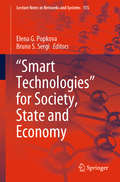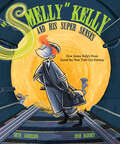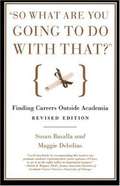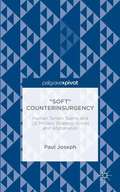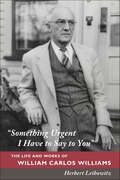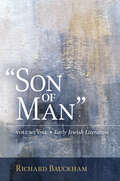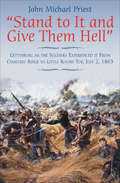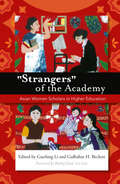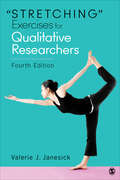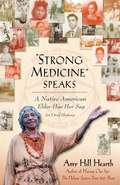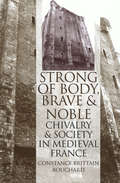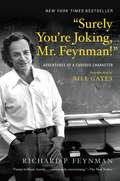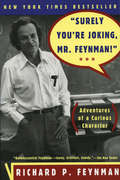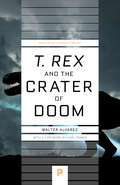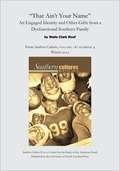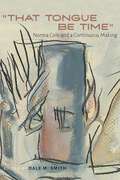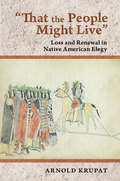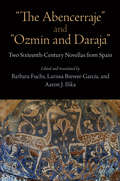- Table View
- List View
"Smart Technologies" for Society, State and Economy (Lecture Notes in Networks and Systems #155)
by Elena G. Popkova Bruno S. SergiThis proceedings book presents a comprehensive view of “smart” technologies and perspectives of their application in various areas of economic activity. The authors of the book combined the results of the cutting-edge research on the topic of “smart” technologies in the digital economy and Industry 4.0 and developed a unified scientific concept. The current experience has been considered, and the prospects for the application of “smart” technologies in society to promote social advance have been identified. “Smart” technologies in public administration and law, as well as the experience in development of e-government, have been examined. “Smart” technologies in business activity have been studied, and the transition from digital business to business 4.0 has been justified. The book contains the collection of the best works following the results of the 13th International Research-to-Practice Conference “Smart Technologies” for society, state and economy which was run by the Institute of Scientific Communications (ISC) and was held on July 2–3, 2020. The target audience of this book includes researchers investigating fundamental and applied problems of development of “smart” technologies, as well as concerned parties outside the academic community, in particular, representatives of the digital society, high-tech business entities and officials regulating the digital economy and Industry 4.0.
"Smelly" Kelly and His Super Senses: How James Kelly's Nose Saved the New York City Subway
by Beth AndersonNSTA Best STEM Book James "Smelly" Kelly used his super-senses and intelligence to make sure that the New York City subway in the 1930s ran safely throughout his lifetime and beyond.James Kelly smelled EVERYTHING: rats in the shed; circus elephants a mile away; tomorrow's rain. His sense of smell was EXTRAORDINARY. But what good was a powerful nose? How could his super-sniffer make him special? In the New York City subway, James found his calling--and earned the nickname "Smelly" Kelly. Armed with his super-sniffer and the tools he invented, he tracked down leaks from the dangerous to the disgusting, from the comical to the bizarre. Then, he sprang into action to prevent cave-ins and explosions in the tunnels beneath the city. Smelly Kelly not only hunted leaks but also saved lives--and he discovered the truly extraordinary power inside him. Beth Anderson's fast-paced text and Jenn Harney's comical illustrations bring to life this everyday superhero.
"So What Are You Going to Do with That?" Finding Careers Outside Academia (Revised Edition)
by Susan Basalla Maggie DebeliusA witty, accessible guide full of concrete advice for anyone contemplating the jump from scholarship to the outside world and covers topics ranging from career counseling to interview etiquette to translating skills learned in the academy into terms an employer can understand and appreciate.
"So What Are You Going to Do with That?": Finding Careers Outside Academia
by Susan Basalla Maggie DebeliusGraduate schools churn out tens of thousands of PhDs and MAs every year. Yet more than half of all college courses are taught by adjunct faculty, which means that the chances of an academic landing a tenure-track job seem only to shrink as student loan and credit card debts grow. What’s a frustrated would-be scholar to do? Can she really leave academia? Can a job outside the academy really be rewarding? And could anyone want to hire a grad-school refugee? In this third edition of “So What Are You Going to Do with That?”, thoroughly revised with new advice for students in the sciences, Susan Basalla and Maggie Debelius—PhDs themselves—answer all those questions with a resounding “Yes!” A witty, accessible guide full of concrete advice for anyone contemplating the jump from scholarship to the outside world, “So What Are You Going to Do with That?” covers topics ranging from career counseling to interview etiquette to how to translate skills learned in the academy into terms an employer can understand and appreciate. Packed with examples and stories from real people who have successfully made this daunting—but potentially rewarding—transition, and written with a deep understanding of both the joys and difficulties of the academic life, this fully updated guide will be indispensable for any graduate student or professor who has ever glanced at his or her CV, flipped through the want ads, and wondered, “What if?”
"Soft" Counterinsurgency: Human Terrain Teams and US Military Strategy in Iraq and Afghanistan
by Paul JosephSoft Counterinsurgency reviews the promises and achievements of Human Terrain Teams, the small groups of social scientists that were eventually embedded in every combat brigade in Iraq and Afghanistan.
"Something Urgent I Have to Say to You": The Life and Works of William Carlos Williams
by Herbert LeibowitzHerbert Leibowitz's "Something Urgent I Have to Say to You" provides a new perspective on the life and poetry of the doctor poet William Carlos Williams, a key American writer who led one of the more eventful literary lives of the twentieth century. Friends with most of the contemporary innovators of his era-Ezra Pound, James Joyce, Ford Madox Ford, and Louis Zukofsky, among others-Williams made a radical break with the modernist tradition by seeking to invent an entirely fresh and singularly American poetic, whose subject matter derived from the everyday lives of the citizens and poor immigrant communities of northern New Jersey. His poems mirrored both the conflicts of his own life and the convulsions that afflicted American society-two world wars, a rampaging flu pan-demic, and the Great Depression.Leibowitz's biography offers a compelling description of the work that inspired a seminal, controversial movement in American verse, as well as a rounded portrait of a complicated man: pugnacious and kindly, ambitious and insecure, self-critical and imaginative. "Something Urgent I Have to Say to You" is both a long-overdue assessment of a major American writer and an entertaining examination of the twentieth-century avant-garde art and poetry scene, with its memorable cast of eccentric pioneers, including Marcel Duchamp, Man Ray, Marianne Moore, and Gertrude Stein.
"Son of Man": Early Jewish Literature
by Richard BaukhamWho is the &“Son of Man&”? In pre-Christian Jewish writings, &“Son of Man&” was not a title, and it certainly did not indicate divinity. It was simply an expression for a man. Yet the term has held considerable interest among scholars of Christology for its use in describing Jesus in the gospels. And among those studying messianism in Second Temple Judaism, consensus about the valences of &“Son of Man&” in Scripture remains elusive. In the first volume of this landmark study, Richard Bauckham pushes the conversation forward, explicating the phrase &“Son of Man&” as it appears in Jewish interpretations of the book of Daniel and in the apocryphal book of 1 Enoch. With philological precision and sensitivity to his sources, Bauckham attunes us to the realities of early Jewish eschatology. Thorough and comprehensive, &“Son of Man,&” vol. 1, offers scholars a solid basis for understanding the context of the messiah in the centuries leading up to Jesus. Along with the forthcoming second volume, which parses the meaning of &“Son of Man&” in the Gospels, Bauckham&’s work is essential for understanding one of the most widely used yet misunderstood phrases in the Bible.
"Spirits that I've cited...?" Vladimír Clementis (1902–1952): The Political Biography of a Czechoslovak Communist
by Josette BaerBaer's biography of the former Czechoslovak foreign minister Vladimír Clementis (1902–1952) is the first historical study on the Communist politician who was executed with Rudolf Slánský and other top Communist Party members after the show trial of 1952. Born in Tisovec, Central Slovakia, Clementis studied law at Charles University in Prague in the 1920s and had his own law firm in Bratislava in the 1930s. After the Munich Agreement of 1938, he went into exile to France and Great Britain, where he worked at the Czechoslovak broadcast at the BBC for the exile government of Edvard Beneš. After the Second World War, Clementis' political career at the Czechoslovak Foreign Ministry blossomed. In 1945, he became Assistant Secretary of State under Foreign Minister Jan Masaryk. After Masaryk's mysterious death in 1948, Clementis was appointed foreign minister. This biography offers an unprecedented insight into the mind of a Slovak leftist intellectual of the interwar generation who died at the command of the comrade he had admired since his youth: Generalissimus Stalin.
"Stand to It and Give Them Hell": Gettysburg as the Soldiers Experienced it From Cemetery Ridge to Little Round Top, July 2, 1863
by John Michael PriestStand to It and Give Them Hell chronicles the Gettysburg fighting from Cemetery Ridge to Little Round Top on July 2, 1863, through the letters, memoirs, diaries, and postwar recollections of the men from both armies who struggled to control that hallowed ground.John Michael Priest, dubbed the Ernie Pyle of the Civil War soldier, wrote this book to help readers understand and experience, as closely as possible through the written word, the stress and terror of that fateful day in Pennsylvania. Readers will gain a deeper appreciation of the personal sacrifice made that awful day by privates and generals alike. This invaluable method uses their own words to paint a rich tapestry of their personal courage and cowardice, and their failures and triumphs.Nearly 60 detailed maps, mostly on the regimental level, illustrate the tremendous troop congestion in the Wheatfield, the Peach Orchard, and Devils Den. They accurately establish, by regiment or by company, the extent of the Federal skirmish line from Zieglers Grove to the Slyder farm and portray the final Confederate push against the Codori farm and the center of Cemetery Ridge, which three Confederate divisions in what is popularly known as Picketts Charge would unsuccessfully attack on the final day of fighting.This is a book about combat as seen through the eyes of those who waged it. There is no glamour here, and no adventure. Nor are there accusations, confessions, or second-guessing from the comfort of an easy chair. Instead, Stand to It and Give Them Hell offers the brutal, heart-wrenching story of a slice of Americas greatest battle as described by those who marched, fought, bled, and died there. This is their story, and it is one you will long remember.
"Step By Step" Workbook
by Laura StollTo the Teacher... This workbook has been prepared especially for sixth graders in our parochial schools, to be used with the textbook STEP BY STEP. In addition to previous revisions, we again made some changes in 2020 to improve clarity on exercises that have at times been confusing to students. Word Studies are also added throughout the workbook on words listed after the stories in the textbook. Each story and poem can be used as a lesson by itself or combined however you wish. You will notice there are nine units with a review after each one. The tests that go with this workbook were designed with a six-week grading period in mind, so they do not necessarily come at the end of a unit. We tried to clearly mark where the tests come in so as to avoid confusion. The tests are available separately at the address below.
"Strangers" of the Academy: Asian Women Scholars in Higher Education
by Guofang Li Gulbahar H. BeckettNo less than other minorities, Asian women scholars are confronted with racial discrimination and stereotyping as well as disrespect for their research, teaching, and leadership, and are underrepresented in academia. In the face of such barriers, many Asian female scholars have developed strategies to survive and thrive. This book is among the first to examine their lived experience in Western academic discourses. It addresses the socio-cultural, political, academic, and personal issues that Asian female scholars encounter in higher education. The contributors to this book include first- and second-generation immigrants who are teachers and researchers in higher education and who come from a wide range of Asian nations and backgrounds. They here combine new research and personal narratives to explore the intersecting layers of relationships that impact their lives—language, culture, academic discourses, gender, class, generation, and race. The book is replete with the richness and complexity of these scholars’ struggles and triumphs in their professional and personal realms.This powerful and engaging volume:* Examines and celebrates the struggles and triumphs that Asian female scholars experience as they try to “make it” in academic environments that may differ sharply from the culture of their countries of origin; * Highlights the unique contributions the authors have made to research, theory, and the profession;* Establishes the authors’ claim to visibility and a voice for themselves and more generally for Asian women in the academy; * Opens a dialogue on these critical issues by sharing the academic and personal experiences of senior and junior scholars alike; and * Contributes to the on-going discussion on issues pertinent to the status of minority female scholars in higher education.
"Stretching" Exercises for Qualitative Researchers
by Valerie J. JanesickIn the new Fourth Edition of her inventive, one-of-a-kind book, author Valerie J. Janesick uses dance, yoga, and meditation metaphors to help researchers tap into the intuitive and creative side of their research. In every chapter, "stretching" exercises help readers develop, practice, and hone fieldwork skills and vital habits of mind such as observation, interviewing, writing, creativity, technology, and analysis. While reading the book and working through the exercises, readers can complete a researcher’s reflective journal—an invaluable tool that will remain useful throughout their careers.
"Stretching" Exercises for Qualitative Researchers
by Valerie J. JanesickIn the new Fourth Edition of her inventive, one-of-a-kind book, author Valerie J. Janesick uses dance, yoga, and meditation metaphors to help researchers tap into the intuitive and creative side of their research. In every chapter, "stretching" exercises help readers develop, practice, and hone fieldwork skills and vital habits of mind such as observation, interviewing, writing, creativity, technology, and analysis. While reading the book and working through the exercises, readers can complete a researcher’s reflective journal—an invaluable tool that will remain useful throughout their careers.
"Strong Medicine" Speaks: A Native American Elder Has Her Say
by Amy Hill Hearth"Strong Medicine" Gould is an eighty-five-year-old Elder in her Lenni-Lenape tribe and community. Taking turns with the author as the two women alternate voices throughout this moving book, Strong Medicine tells of her ancestry.
"Strong of Body, Brave and Noble": Chivalry and Society in Medieval France
by Constance Brittain BouchardMedieval society was dominated by its knights and nobles. The literature created in medieval Europe was primarily a literature of knightly deeds, and the modern imagination has also been captured by these leaders and warriors. This book explores the nature of the nobility, focusing on France in the High Middle Ages (11th-13th centuries). Constance Brittain Bouchard examines their families; their relationships with peasants, townspeople, and clerics; and the images of them fashioned in medieval literary texts. She incorporates throughout a consideration of noble women and the nobility's attitude toward women.Research in the last two generations has modified and expanded modern understanding of who knights and nobles were; how they used authority, war, and law; and what position they held within the broader society. Even the concepts of feudalism, courtly love, and chivalry, once thought to be self-evident aspects of medieval society, have been seriously questioned. Bouchard presents bold new interpretations of medieval literature as both reflecting and criticizing the role of the nobility and their behavior. She offers the first synthesis of this scholarship in accessible form, inviting general readers as well as students and professional scholars to a new understanding of aristocratic role and function.
"Surely You're Joking, Mr. Feynman!": Adventures of a Curious Character
by Bill Gates Ralph Leighton Richard P. FeynmanOne of the most famous science books of our time, the phenomenal national bestseller that "buzzes with energy, anecdote and life. It almost makes you want to become a physicist" (Science Digest). Richard P. Feynman, winner of the Nobel Prize in physics, thrived on outrageous adventures. In this lively work that “can shatter the stereotype of the stuffy scientist” (Detroit Free Press), Feynman recounts his experiences trading ideas on atomic physics with Einstein and cracking the uncrackable safes guarding the most deeply held nuclear secrets—and much more of an eyebrow-raising nature. In his stories, Feynman’s life shines through in all its eccentric glory—a combustible mixture of high intelligence, unlimited curiosity, and raging chutzpah. Included for this edition is a new introduction by Bill Gates.
"Surely You're Joking, Mr. Feynman!": Adventures of a Curious Character
by Ralph Leighton Richard P. FeynmanA New York Times bestseller--the outrageous exploits of one of this century's greatest scientific minds and a legendary American original. Richard Feynman, winner of the Nobel Prize in physics, thrived on outrageous adventures. Here he recounts in his inimitable voice his experience trading ideas on atomic physics with Einstein and Bohr and ideas on gambling with Nick the Greek; cracking the uncrackable safes guarding the most deeply held nuclear secrets; accompanying a ballet on his bongo drums; painting a naked female toreador. In short, here is Feynman's life in all its eccentric--a combustible mixture of high intelligence, unlimited curiosity, and raging chutzpah.
"T. rex" and the Crater of Doom
by Carl Zimmer Walter AlvarezSixty-five million years ago, a comet or asteroid larger than Mt. Everest slammed into the Earth, causing an explosion equivalent to the detonation of a hundred million hydrogen bombs. Vaporized impactor and debris from the impact site were blasted out through the atmosphere, falling back to Earth all around the globe. Terrible environmental disasters ensued, including a giant tsunami, continent-scale wildfires, darkness, and cold, followed by sweltering greenhouse heat. When conditions returned to normal, half the genera of plants and animals on Earth had perished.This horrific story is now widely accepted as the solution to a great scientific murder mystery what caused the extinction of the dinosaurs? In T. rex and the Crater of Doom, the story of the scientific detective work that went into solving the mystery is told by geologist Walter Alvarez, one of the four Berkeley scientists who discovered the first evidence for the giant impact. It is a saga of high adventure in remote parts of the world, of patient data collection, of lonely intellectual struggle, of long periods of frustration ended by sudden breakthroughs, of intense public debate, of friendships made or lost, of the exhilaration of discovery, and of delight as a fascinating story unfolded.Controversial and widely attacked during the 1980s, the impact theory received confirmation from the discovery of the giant impact crater it predicted, buried deep beneath younger strata at the north coast of the Yucatán Peninsula. The Chicxulub Crater was found by Mexican geologists in 1950 but remained almost unknown to scientists elsewhere until 1991, when it was recognized as the largest impact crater on this planet, dating precisely from the time of the great extinction sixty-five million years ago. Geology and paleontology, sciences that long held that all changes in Earth history have been calm and gradual, have now been forced to recognize the critical role played by rare but devastating catastrophes like the impact that killed the dinosaurs.
"T. rex" and the Crater of Doom
by Carl Zimmer Walter AlvarezSixty-five million years ago, a comet or asteroid larger than Mount Everest slammed into the Earth, inducing an explosion equivalent to the detonation of a hundred million hydrogen bombs. Vaporized detritus blasted through the atmosphere upon impact, falling back to Earth around the globe. Disastrous environmental consequences ensued: a giant tsunami, continent-scale wildfires, darkness, and cold, followed by sweltering greenhouse heat. When conditions returned to normal, half the plant and animal genera on Earth had perished.This horrific chain of events is now widely accepted as the solution to a great scientific mystery: what caused the extinction of the dinosaurs? Walter Alvarez, one of the Berkeley scientists who discovered evidence of the impact, tells the story behind the development of the initially controversial theory. It is a saga of high adventure in remote locations, of arduous data collection and intellectual struggle, of long periods of frustration ended by sudden breakthroughs, of friendships made and lost, and of the exhilaration of discovery that forever altered our understanding of Earth's geological history.
"T. rex" and the Crater of Doom
by Carl Zimmer Walter AlvarezSixty-five million years ago, a comet or asteroid larger than Mount Everest slammed into the Earth, inducing an explosion equivalent to the detonation of a hundred million hydrogen bombs. Vaporized detritus blasted through the atmosphere upon impact, falling back to Earth around the globe. Disastrous environmental consequences ensued: a giant tsunami, continent-scale wildfires, darkness, and cold, followed by sweltering greenhouse heat. When conditions returned to normal, half the plant and animal genera on Earth had perished.This horrific chain of events is now widely accepted as the solution to a great scientific mystery: what caused the extinction of the dinosaurs? Walter Alvarez, one of the Berkeley scientists who discovered evidence of the impact, tells the story behind the development of the initially controversial theory. It is a saga of high adventure in remote locations, of arduous data collection and intellectual struggle, of long periods of frustration ended by sudden breakthroughs, of friendships made and lost, and of the exhilaration of discovery that forever altered our understanding of Earth's geological history.
"That Ain’t Your Name”: An Engaged Identity and Other Gifts from a Dysfunctional Southern Family
by Wade Clark RoofIt was not until 1946 when my grandmother received a copy of the revised birth certificate in the mail from my father and blurted out to me 'That ain't your name,' that I really became aware of the problems. She quickly added, 'Your mother, she never got it right neither.'"This article appears in the Winter 2012 issue of Southern Cultures. The full issue is also available as an ebook.Southern Cultures is published quarterly (spring, summer, fall, winter) by the University of North Carolina Press. The journal is sponsored by the University of North Carolina at Chapel Hill's Center for the Study of the American South.
"That Tongue Be Time": Norma Cole and a Continuous Making (Path to Open)
by Dale M. SmithOriginally from Canada, Norma Cole is a revered writer and visual artist who has authored and translated over thirty books and chapbooks. Though highly esteemed internationally in both visual art and poetry circles, Cole&’s association with the New College of California and her influence on artists and poets has been overlooked by scholars. In &“That Tongue Be Time,&” Dale M. Smith seeks to remedy this oversight by bringing together sixteen noted scholars, editors, and poets to examine Cole&’s poetry, translations, and visual art in order to place her within the larger scholarly conversation about contemporary poetry and poetics. The book also includes a number of black-and-white reproductions of Cole&’s art and a contextual introduction by Smith. &“That Tongue Be Time&” provides a groundbreaking look at Norma Cole&’s lasting influence on multiple generations of poets, visual artists, and scholars and should be on the shelf of anyone interested in contemporary poetry.
"That the People Might Live": Loss and Renewal in Native American Elegy
by Arnold KrupatThe word "elegy" comes from the Ancient Greek elogos, meaning a mournful poem or song, in particular, a song of grief in response to loss. Because mourning and memorialization are so deeply embedded in the human condition, all human societies have developed means for lamenting the dead, and, in "That the People Might Live" Arnold Krupat surveys the traditions of Native American elegiac expression over several centuries.Krupat covers a variety of oral performances of loss and renewal, including the Condolence Rites of the Iroquois and the memorial ceremony of the Tlingit people known as koo'eex, examining as well a number of Ghost Dance songs, which have been reinterpreted in culturally specific ways by many different tribal nations. Krupat treats elegiac "farewell" speeches of the eighteenth and nineteenth centuries in considerable detail, and comments on retrospective autobiographies by Black Hawk and Black Elk.Among contemporary Native writers, he looks at elegiac work by Linda Hogan, N. Scott Momaday, Gerald Vizenor, Sherman Alexie, Maurice Kenny, and Ralph Salisbury, among others. Despite differences of language and culture, he finds that death and loss are consistently felt by Native peoples both personally and socially: someone who had contributed to the People's well-being was now gone. Native American elegiac expression offered mourners consolation so that they might overcome their grief and renew their will to sustain communal life.
"The Abencerraje" and "Ozmin and Daraja"
by Barbara Fuchs Aaron J. Ilika Larissa Brewer-GarciaSince its publication in 1561, an anonymous tale of love, friendship, and chivalry has captivated readers in Spain and across Europe. "The Abencerraje" tells of the Moorish knight Abindarráez, whose plans to wed are interrupted when he is taken prisoner by Christian knights. His captor, a Spanish governor, befriends and admires the Moorish knight, ultimately releasing him to marry his beloved. Their enormously popular tale was repeated or imitated in numerous ballads and novels; when the character Don Quixote is wounded in his first sortie, he imagines himself as Abindarráez on the field.Several decades later, in the tense years leading up to the expulsion of the Moriscos from Spain, Mateo Alemán reprised themes from this romance in his novel Guzmán de Alfarache. In his version, the Moorish lady Daraja is captured by the Catholic monarchs Ferdinand and Isabel; she and her lover Ozmín are forced to engage in a variety of ruses to protect their union until they are converted to Christianity and married. Though "Ozmín and Daraja" is more elaborate in execution than "The Abencerraje," both tales show deep sympathy for their Moorish characters.Faithfully translated into modern, accessible English, these finely wrought literary artifacts offer rich imaginings of life on the Christian-Muslim frontier. Contextualized with a detailed introduction, along with contemporary legal documents, polemics, and ballads, "The Abencerraje" and "Ozmín and Daraja" reveals early modern Spain's profound fascination with the Moorish culture that was officially denounced and persecuted. By recalling the intimate and sympathetic bonds that often connected Christians to the heritage of Al-Andalus, these tales of romance and companionship offer a nuanced view of relationships across a religious divide.
